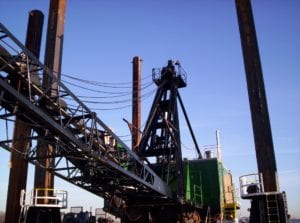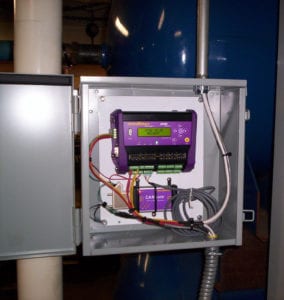dataTaker Solution Monitors Emissions & CO2 Generation
A significant percentage of the seagoing freight that enters the US comes through the port of New York. Keeping the harbor open is a full-time job that requires constant dredging to allow ever-larger ocean-going vessels to safely navigate to the freight terminal. Each of these dredging barges employs multiple diesel engines to run generators and hydraulic pumps for the dredge cranes and other equipment. The operation is overseen by the Army Corps of Engineers and the EPA. Emissions regulations for diesel engines require constant monitoring to assess CO2 generation and other emissions. Documented compliance with EPA standards is essential to maintaining the ongoing process of the dredging operation as well as avoiding potential fines for violations.
Installation
To provide continuous diesel engine monitoring each power unit is fitted with a dataTaker DT80 data logger and where appropriate, a CANgate CANbus to a serial gateway. At a minimum, run time and fuel consumption need to be recorded for each engine. When applicable, engine RPM, engine load, and coolant temperatures are monitored to capture engine performance.
Newer Engines
On newer engines, all of these parameters are typically available from the engine electronic control unit (ECU) via the J1939 CANbus. Using the CANgate bundled with the dataTaker DT80 allows periodic recording of all of these critical parameters. Using one of the digital inputs of the data logger wired to a simple oil pressure switch as a trigger allows the recording of data only while the engine is in operation.
Older Engines
Older engines that lack an ECU present more of a challenge – but this can be accommodated with the same data logger. The engine is simply fitted with a series of sensors that monitor variables that would normally be available via the CANbus on newer engines. Sensors might include magnetic pickup for engine RPM, thermocouples for coolant and other temperatures, and a flow meter to capture fuel consumption. The flexibility of the universal analog inputs along with the digital/high-speed counters provides the ability to record data from almost any type of sensor with one device. In addition, the ability to define calculations and software totalizers allows for the generation of derived parameters such as total run time and total fuel used. If necessary, an RPM/fuel flow map can also be used to approximate the engine load.
 Data Access
Data Access
A key part of the monitoring process is to generate reports for evaluation by the Corps of Engineers and EPA. To accomplish this, the USB memory stick port of the data logger can be used to quickly download data in an EXCEL-compatible format. A simple procedure allows the dredge captain to download the data from multiple engines, import the data into a spreadsheet, and quickly generate a report that summarizes daily operating information.
For more information on the dataTaker DT80 Data Logger, diesel engine monitoring or to find the ideal solution for your application-specific needs, contact a CAS DataLogger Application Specialist at (800) 956-4437 or request more information.

